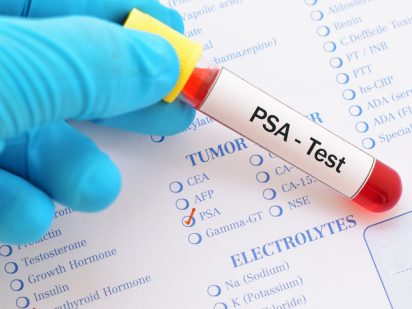If you’re an over-40 male and unsure about when to begin routine prostate cancer screening, you are not alone. Confusion about the efficacy of prostate specific antigen (PSA) blood tests for the early detection of prostate cancer has been widespread ever since a federal panel recommended against them, at least for healthy men. That was 10 years ago.
Today, the PSA controversy has mostly subsided. The same federal panel that disparaged PSA screening has softened its stance. Trusted sources like the American Cancer Society (ACS) have continued to recommend PSA tests as a screening tool, albeit with the addition of cautionary language that adds nuance to the endorsement. (See ACS guidelines at the end of this article.)
But while the question of whether healthy men should be screened for prostate cancer has become an individual choice arrived at in consultation with a healthcare provider, one thing hasn’t changed: screening can save lives.
“Screening helps us detect cancer earlier, which enhances the prospect of being able to recommend treatment plans that include lower-risk options,” said Joon Lee, MD, a radiation oncologist at the Trinity Health CancerCare Center. “Depending on a man’s age and the extent of cancer, treatment might not even be necessary; we can do what is called ‘active surveillance,’ which involves monitoring the cancer and only treating it if there are signs that it’s progressing.”
The most common type of cancer in American men other than skin cancer, prostate cancer strikes one in eight American males. Although men of any age can get prostate cancer, it is found most often in men over 50. The American Cancer Society estimates that 268,490 new cases of prostate cancer will be diagnosed in the United States this year, and about 34,500 men will die of the disease.
According to Lee, the prognosis for prostate cancer has improved over the years thanks to more precise imaging, staging and targeted therapies. “Multiparametric MRI is one of the latest and most effective tools for detecting prostate cancer,” Lee said. “It supplements ordinary MRI scans with additional imaging to provide us with detailed anatomical information about the patient’s prostate gland.”
Doctors assess prostate cancer with something called the Gleason Score, a system named for pathologist Donald Gleason, MD, who recognized that cancerous cells fall into distinct patterns as they change from normal cells to tumor cells. “The Gleason score helps us determine the aggressiveness of the cancer, which is useful when it comes to choosing the appropriate treatment,” Lee said.
Men with a diagnosis of prostate cancer can expect wrap-around care from Trinity’s cancer physicians and staff, including a thorough discussion about treatment options. Doctors may recommend one treatment or a combination of treatments. Men with lower-risk prostate cancer generally are candidates for surgery, hormone therapy, or external beam radiation therapy (EBRT), Dr. Lee’s specialty. In EBRT, beams of radiation are focused on the prostate gland using one of Trinity’s advanced linear accelerators.
“It is the same system that Johns Hopkins has with all the bells and whistles,” Lee says. The state-of-the-art technology targets tumors and positions patients precisely so a higher dose of radiation can be delivered to the tumor while sparing nearby tissue. “We have a great team, great technology, and we have the expertise and human resources to provide world-class care.”
And, as a member of the Mayo Clinic Care Network, Trinity Health has access to the expertise that Mayo Clinic has to offer. “If we have a question about a patient or a course of treatment, we can arrange a consultation without the patient having to travel,” Lee adds.
Prostate Cancer Screening Guidelines
The American Cancer Society recommends that men make an informed decision with their healthcare provider about whether to be screened for prostate cancer. The decision should be made after getting information about the uncertainties, risks, and potential benefits. PSA screening is recommended at the following ages:
- Age 50 for men who are at average risk of prostate cancer and are expected to live at least 10 more years.
- Age 45 for men at high risk of developing prostate cancer. This includes African Americans and men who have a first-degree relative (father or brother) diagnosed with prostate cancer at an early age (younger than age 65).
- Age 40 for men at even higher risk (those with more than one first-degree relative who had prostate cancer at an early age).

